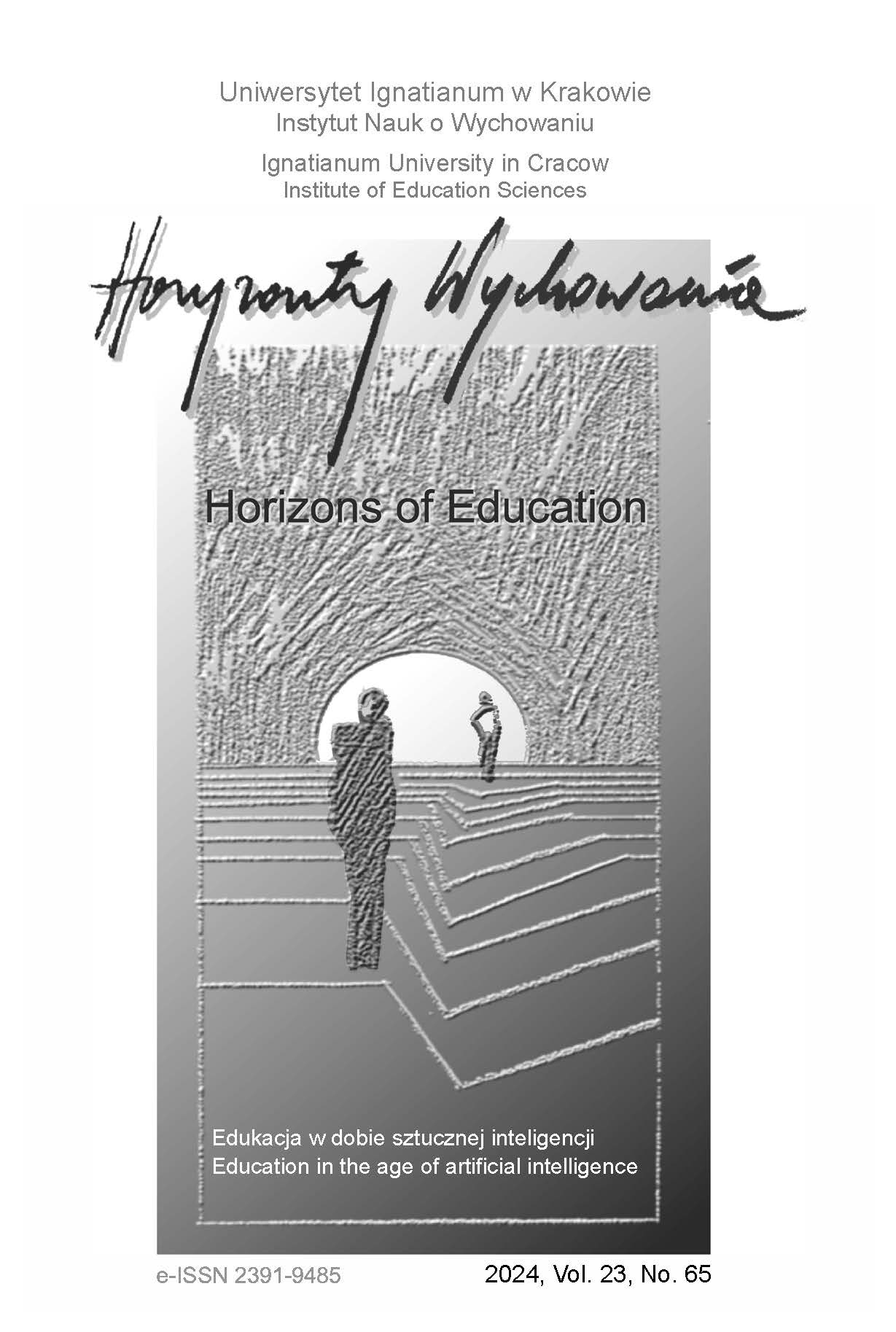Young People’s Preferences Regarding Classical Music and Gender: The Educational Context of a Study Carried out in Poland
Abstract
RESEARCH OBJECTIVE: The aim of the study was to diagnose young people’s preferences for classical music and to determine whether gender is related to them.
THE RESEARCH PROBLEM AND METHODS: In the study a problem was formulated in relation to women’s and men’s musical preferences for classical music. A diagnostic survey method and a questionnaire technique were used in the research.
THE PROCESS OF ARGUMENTATION: Although classical music is the subject of intensive educational efforts it is still on the margins of young people’s musical preferences. Among the determinants of these preferences is gender. However, this is a variable that is rarely included in research.
RESEARCH RESULTS: No relationship was found between gender and areas of preference to- wards classical music – attitudes towards listening to it, favourite composers and forms of musical activity. However, women more often listened to classical music. Besides, more women than men expressed the opinion that the development of interest in this music lays on school, family, the media and cultural institutions.
CONCLUSIONS, RECOMMENDATIONS AND APPLICABLE VALUE OF RESEARCH: Gender did not show a clear association with preferences for classical music. The results of the study may inspire further exploration in this area and provide a rationale for multidirectional activities to develop interests in this music.
References
CBOS. (2018). Słuchanie muzyki. Komunikat z Badań, 102, 1–10. https://www.cbos.pl/SPISKOM.POL/2018/K_102_18.PDF
CBOS. (2021). Co czwarty Polak śledził Konkurs Chopinowski. CBOS News. Newsletter, 37. https://www.cbos.pl/PL/publikacje/news/newsletter_ver3.php?news_r=2021&news_nr=37
Colley, A. (2008). Young people’s musical taste: relationship with gender and gender-related traits. Journal of Applied Social Psychology, 38(8), 2039–2055. https://doi.org/10.1111/j.1559-1816.2008.00379.x
Grusiewicz, M. (2011). Kompetencje muzyczne uczniów ogólnokształcących szkół podstawowych i gimnazjów. Stowarzyszenie Nauczycieli Muzyki.
Grusiewicz, M. (2019). Edukacja muzyczna – w stronę współczesnej kultury. Lubelski Rocznik Pedagogiczny, 38(1), 113–129. https://doi.org/10.17951/lrp.2019.38.1.113-129
Grusiewicz, M. (2020). Współczesne wyzwania powszechnej edukacji muzycznej. Przemiany na świecie a polskie reformy. Annales Universitatis Mariae Curie-Skłodowska. Sectio J. Paedagogia-Psychologia, 33(2), 103–116. https://doi.org/10.17951/j.2020.33.2.103-116
Kamińska, B. (2002). Upodobania muzyczne – problemy i wyniki badań. In A. Białkowski & B. Smoleńska-Zielińska (Eds.), Bliżej muzyki, bliżej człowieka (pp. 233–252). Wydawnictwo UMCS.
Kołodziejski, M. (2017). Preferencje muzyczne młodzieży płockich szkół średnich w kontekście edukacyjnym. Ars inter Culturas, 6, 215–238.
LeBlanc, A., Jin, Y., Stamou, L., & McCrary, J. (1999). Effect of age, country, and gender on music listening preferences. Bulletin of the Council for Research in Music Education, 141, 72–76.
LeBlanc, A., Sims, W.L., Siivola, C., & Obert, M. (1996). Music style preferences of different age listeners. Journal of Research in Music Education, 44(1), 49–59. https://doi.org/10.2307/3345413
Lorenzo-Quiles, O., Soares-Quadros J.F., Jr, & Abril, J.E. (2020). Musical preferences of Brazilian high school students. PLoS ONE, 15(9), 1–15. https://doi.org/10.1371/journal.pone.0239891
Manturzewska, M. (2001). Zdolności, kompetencje i postawy muzyczne naszej młodzieży w świetle wyników badań. In M. Manturzewska (Ed.), Psychologiczne podstawy kształcenia muzycznego (pp. 85–100). Akademia Muzyczna im. Fryderyka Chopina.
Narodowe Centrum Kultury. (2021). Muzyczne wybory młodzieży. Komunikat z badań Narodowego Centrum Kultury. https://www.nck.pl/badania/aktualnosci/muzyczne-wybory-polskiej-mlodziezy/komunikat-z-badan
Pałosz, P. (2009). Przegląd badań nad uwarunkowaniami preferencji muzycznych. Przegląd Psychologiczny, 52(2), 151–179.
Sloboda, J.A. (2005). Dźwięki a istota muzyki: dylematy badaczy muzycznych emocji. In A. Chmurzyńska (Ed.), Wyzwania i możliwości psychologii muzyki w ujęciu Johna A. Slobody (pp. 71–96). Akademia Muzyczna im. Fryderyka Chopina.
Sloboda, J.A. (2008). Wykłady z psychologii muzyki (A. Miśkiewicz, K. Miklaszewski, M. Chmurzyńska & J.Kobayashi, Trans.). Akademia Muzyczna im. Fryderyka Chopina.
Soares-Quadros Júnior, J.F., Lorenzo, O., Herrera, L., & Araújo Santos, N.S. (2019). Gender and religion as factors of individual differences in musical preference. Musicae Scientiae, 23(4), 525–539. https://doi.org/10.1177/1029864918774834
Sojka, A. (2011). Kultura muzyczna współczesnej młodzieży a edukacja artystyczna. In B. Żurakowski (Ed.), Kultura artystyczna w przestrzeni wychowania (pp. 199–209). Wydawnictwo Uniwersytetu Jagiellońskiego.
Szubertowska, E. (2003). Edukacja a kultura muzyczna młodzieży. Wydawnictwo Akademii Bydgoskiej.
Szubertowska, E. (2013). Muzyka w mediach – szansa czy zagrożenie dla edukacji i kultury muzycznej narodu. Muzyka, Historia, Teoria, Edukacja, 3, 120–131. https://doi.org/10.34767/MHTE.2013.03.10
Tayyebi, S.F., Demir, Y., Nemutlu, M., & Karadoğan, C. (2020). Graphical layout of the musical preferences studies: an overview on how the studies on musical tastes are conducted, Art and Design Review, 8(1), 6–30. https://doi.org/10.4236/adr.2020.81002
Teklos, P. (2011). An investigation into pupils’ attitudes towards secondary music education in Cyprus. [Thesis submitted for the Degree of Doctor of Philosophy in the University of Hull.] https://core.ac.uk/download/pdf/9841772.pdf
Copyright (c) 2023 HORIZONS OF EDUCATION

This work is licensed under a Creative Commons Attribution-NoDerivatives 4.0 International License.
Authors who publish in this journal agree to the following terms:
- Authors retain the copyright to their work while granting the journal the right of first publication. The work will be simultaneously licensed under a CC BY-ND license, which permits others to share the work with proper credit given to the author and the original publication in this journal.
- Authors may enter into additional, non-exclusive agreements for the distribution of the published version of the work (e.g., posting it in an institutional repository or publishing it in another journal), provided that the original publication in this journal is acknowledged.
We allow and encourage authors to share their work online (e.g., in institutional repositories or on personal websites) both before and during the submission process, as this can foster beneficial exchanges and lead to earlier and increased citations of the published work. (See The Effect of Open Access). We recommend using any of the following academic networking platforms:





